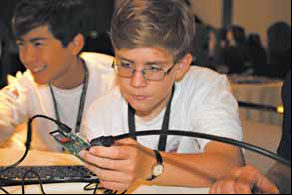A tiny computer attracts tinkerers
Updated: 2013-03-24 07:57
By John Biggs(The New York Times)
|
|||||||
|
The $35 Raspberry Pi, intended for computer science students, is the world's cheapest computer and a top seller. Broadcom Masters |
Raspberry Pi may sound like the name of a math-based dessert. But it is actually one of the hottest and cheapest little computers in the world right now. Almost one million of these $35 machines have shipped since February 2012, capturing the imaginations of educators, hobbyists and tinkerers around the world.
The story of the Raspberry Pi began in 2006 when Eben Upton and other faculty members at the University of Cambridge in Britain found that their incoming computer science students were ill-prepared for a high-tech education. While many students in the previous decade were experienced electronics hobbyists by the time they got to college, these freshmen were little more than skilled Web designers.
Easy-to-use, modern PCs hide most of the nuts and bolts behind a pleasing interface. Mr. Upton posited that parents did not want their children to destroy their expensive computers by experimenting with their insides. But a cheaper machine would be fair game for messing around.
The Raspberry Pi, which is about the size of a credit card, was intended to replace the expensive computers in school science labs. For less than the price of a new keyboard, a teacher could plug in the Pi and connect it to older peripherals that might be lying around. But because Pi initially ran only Linux, a free operating system, students would have a learning curve.
The Raspberry Pi Foundation began selling the computers in February of last year. They soon could not keep them in stock.
"We honestly were thinking of this as a 1,000- to 5,000-unit opportunity," Mr. Upton said. "The thing we didn't anticipate was this whole other market of technically competent adults who wanted to use it."
One Pi owner, Dave Akerman, of Brightwalton, England, even sent a Raspberry Pi to the upper atmosphere, floating it 40,000 meters up using a weather balloon. There he was able to take live video, photos and measurements.
"Now every primary school in the world can take pictures from near space," Mr. Upton said. "You give people access to this tool and they do great things."
The Pi is so popular that many distributors are constantly out of stock. It is also difficult to find it for sale online.
"We've sold tens of thousands in weeks," said Limor Fried, founder and engineer at Adafruit Industries, a distributor of the Pi.
The Pi costs $35, or $25 for an older model, and comes as a bare circuit board, although you can buy plastic cases for it.
The Raspberry Pi works best with an HDMI-compatible monitor. It is powered via a standard USB cable. To turn it off, you simply pull out the power cable. Because it has no onboard storage or operating system, you will need to copy the necessary software to a high-capacity SD memory card.
There are programs to let users add features to the Raspberry Pi, including Wi-Fi support and hardware controllers for sensor, motors and more.
Users can even turn the product into a small home media center. Because the Pi has a powerful graphics chip, users have been able to stream video and photos to their television sets using little more than a Pi and a Linux program like RaspbMC.
"I'm not aware of a company that has gone from a standing start to a million in a year," Mr. Upton said. "It's quite a wild ride. I don't get a lot of sleep."
The New York Times
(China Daily 03/24/2013 page11)
